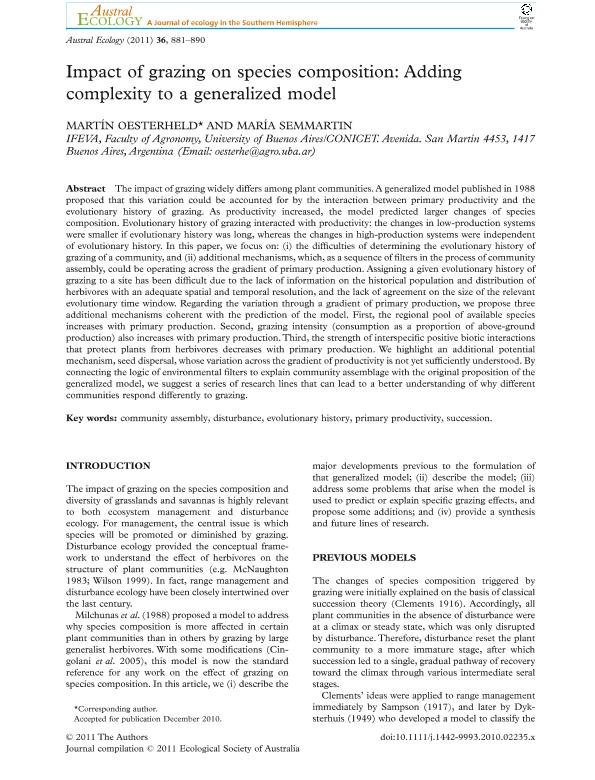Artículo
Impact of grazing on species composition: Adding complexity to a generalized model
Fecha de publicación:
12/2011
Editorial:
Wiley Blackwell Publishing, Inc
Revista:
Austral Ecology
ISSN:
1442-9985
Idioma:
Inglés
Tipo de recurso:
Artículo publicado
Clasificación temática:
Resumen
The impact of grazing widely differs among plant communities. A generalized model published in 1988 proposed that this variation could be accounted for by the interaction between primary productivity and the evolutionary history of grazing. As productivity increased, the model predicted larger changes of species composition. Evolutionary history of grazing interacted with productivity: the changes in low-production systems were smaller if evolutionary history was long, whereas the changes in high-production systems were independent of evolutionary history. In this paper, we focus on: (i) the difficulties of determining the evolutionary history of grazing of a community, and (ii) additional mechanisms, which, as a sequence of filters in the process of community assembly, could be operating across the gradient of primary production. Assigning a given evolutionary history of grazing to a site has been difficult due to the lack of information on the historical population and distribution of herbivores with an adequate spatial and temporal resolution, and the lack of agreement on the size of the relevant evolutionary time window. Regarding the variation through a gradient of primary production, we propose three additional mechanisms coherent with the prediction of the model. First, the regional pool of available species increases with primary production. Second, grazing intensity (consumption as a proportion of above-ground production) also increases with primary production. Third, the strength of interspecific positive biotic interactions that protect plants from herbivores decreases with primary production. We highlight an additional potential mechanism, seed dispersal, whose variation across the gradient of productivity is not yet sufficiently understood. By connecting the logic of environmental filters to explain community assemblage with the original proposition of the generalized model, we suggest a series of research lines that can lead to a better understanding of why different communities respond differently to grazing.
Archivos asociados
Licencia
Identificadores
Colecciones
Articulos(IFEVA)
Articulos de INST.D/INV.FISIOLOGICAS Y ECO.VINCULADAS A L/AGRIC
Articulos de INST.D/INV.FISIOLOGICAS Y ECO.VINCULADAS A L/AGRIC
Citación
Oesterheld, Martin; Semmartin, María Gisela; Impact of grazing on species composition: Adding complexity to a generalized model; Wiley Blackwell Publishing, Inc; Austral Ecology; 36; 8; 12-2011; 881-890
Compartir
Altmétricas




